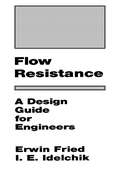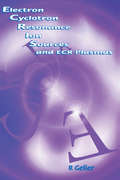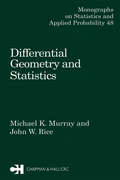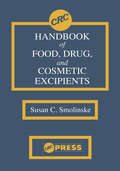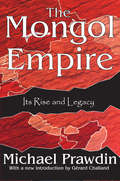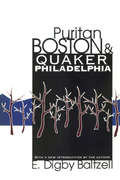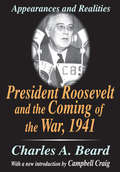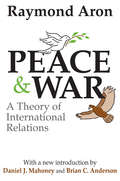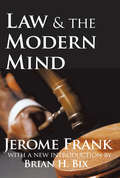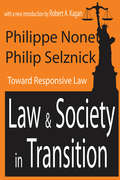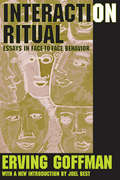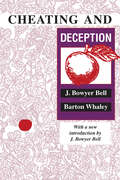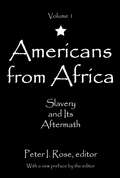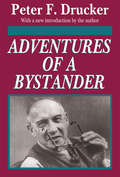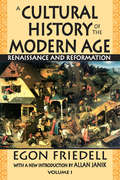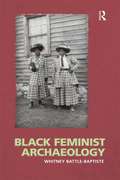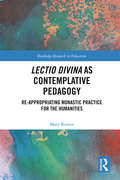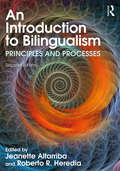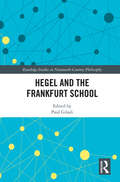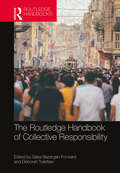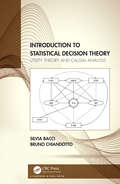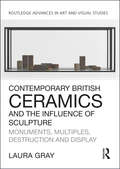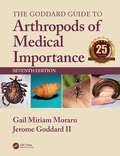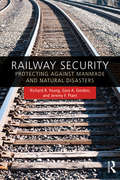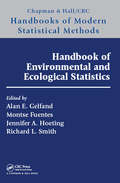- Table View
- List View
Flow Resistance: Design Guide For Engineers
by I.E. IdelchikA sourcebook offering an up-to-date perspective on a variety of topics and using practical, applications-oriented data necessary for the design and evaluation of internal fluid system pressure losses. It has been prepared for the practicing engineer who understands fluid-flow fundamentals.
Electron Cyclotron Resonance Ion Sources and ECR Plasmas
by R GellerAcknowledged as the "founding father" of and world renowned expert on electron cyclotron resonance sources Richard Geller has produced a unique book devoted to the physics and technicalities of electron cyclotron resonance sources. Electron Cyclotron Resonance Ion Sources and ECR Plasmas provides a primer on electron cyclotron phenomena in ion sour
Differential Geometry and Statistics (ISSN)
by M.K. MurraySeveral years ago our statistical friends and relations introduced us to the work of Amari and Barndorff-Nielsen on applications of differential geometry to statistics. This book has arisen because we believe that there is a deep relationship between statistics and differential geometry and moreoever that this relationship uses parts of differential geometry, particularly its 'higher-order' aspects not readily accessible to a statistical audience from the existing literature. It is, in part, a long reply to the frequent requests we have had for references on differential geometry! While we have not gone beyond the path-breaking work of Amari and Barndorff- Nielsen in the realm of applications, our book gives some new explanations of their ideas from a first principles point of view as far as geometry is concerned. In particular it seeks to explain why geometry should enter into parametric statistics, and how the theory of asymptotic expansions involves a form of higher-order differential geometry. The first chapter of the book explores exponential families as flat geometries. Indeed the whole notion of using log-likelihoods amounts to exploiting a particular form of flat space known as an affine geometry, in which straight lines and planes make sense, but lengths and angles are absent. We use these geometric ideas to introduce the notion of the second fundamental form of a family whose vanishing characterises precisely the exponential families.
CRC Handbook of Food, Drug, and Cosmetic Excipients
by Susan C. SmolinskeCRC Handbook of Food, Drug, and Cosmetic Excipients provides a comprehensive summary of toxicological issues regarding inactive ingredients in pharmaceutical products, cosmetic products, and food additives. Background information on regulations and labeling requirements for each type of product is provided, and 77 articles critically review human and animal data pertinent to a variety of agents and makes judgments regarding the clinical relevance. The book also identifies at-risk populations, such as neonates, patients with renal failure, and atopic patients. Inactive common pharmaceutical agents and/or foods containing certain ingredients are listed to help physicians counsel hypersensitive patients who must avoid products containing these excipients.
The Mongol Empire: Its Rise and Legacy
by Michael PrawdinIn his prologue to The Mongol Empire, Michael Prawdin sets the stage for the last and mightiest onslaught of the nomads upon the civilized world. He tells of the many rejoicings in Europe over the successes of the Crusaders in A.D. 1221. But little did Europe know that two decades later, the Mongol hordes organized by Genghis Khan would turn the Middle East into a heap of ruins and spread terror throughout the West. A work of enduring scholarship and literary excellence, The Mongol Empire is a classic on the rise and fall of the world's largest empire. It describes the incredible ascent of the Mongol people, which, through the political and military genius of Genghis Khan, overwhelmed and subdued the nations of most of the world. It demonstrates the transformation of barbarous nomads into the most efficient rulers of their time and describes the crumbling of their vast empire and the assumption of its legacy by the formerly subjugated China and Russia. Maurice Collis in Time and Tide said of The Mongol Empire: "It has the rare merit of being both scholarly and exciting...The entire world comes on to his canvas, romantic and fantastical persons pass in our view, and at the conclusion we realize that we have seen the whole of what Marco Polo saw only in part. " while The Observer commented, "it is a fine book, full of dramatic occasion well used, clear in proportions."
Puritan Boston and Quaker Philadelphia
by E. Digby BaltzellBased on the biographies of some three hundred people in each city, this book shows how such distinguished Boston families as the Adamses, Cabots, Lowells, and Peabodys have produced many generations of men and women who have made major contributions to the intellectual, educational, and political life of their state and nation. At the same time, comparable Philadelphia families such as the Biddles, Cadwaladers, Ingersolls, and Drexels have contributed far fewer leaders to their state and nation. From the days of Benjamin Franklin and Stephen Girard down to the present, what leadership there has been in Philadelphia has largely been provided by self-made men, often, like Franklin, born outside Pennsylvania.Baltzell traces the differences in class authority and leadership in these two cites to the contrasting values of the Puritan founders of the Bay Colony and the Quaker founders of the City of Brotherly Love. While Puritans placed great value on the calling or devotion to one's chosen vocation, Quakers have always placed more emphasis on being a good person than on being a good judge or statesman. Puritan Boston and Quaker Philadelphia presents a provocative view of two contrasting upper classes and also reflects the author's larger concern with the conflicting values of hierarchy and egalitarianism in American history.
President Roosevelt and the Coming of the War, 1941: Appearances and Realities
by Charles BeardConceived by Charles Beard as a sequel to his provocative study of American Foreign Policy in the Making, 1932-1940, President Roosevelt and the Coming of the War outraged a nation, permanently damaging Beard's status as America's most influential historian.Beard's main argument is that both Democratic and Republican leaders, but Roosevelt above all, worked quietly in 1940 and 1941 to insinuate the United States into the Second World War. Basing his work on available congressional records and administrative reports, Beard concludes that FDR's image as a neutral, peace-loving leader was a smokescreen, behind which he planned for war against Germany and Japan even well before the attack on Pearl Harbor.Beard contends that the distinction between aiding allies in Europe like Great Britain and maintaining strict neutrality with respect to nations like Germany and Japan was untenable. Beard does not argue that all nations were alike, or that some did and others did not merit American support, but rather that Roosevelt chose to aid Great Britain secretly and unconstitutionally rather than making the case to the American public. President Roosevelt shifted from a policy of neutrality to one of armed intervention, but he did so without surrendering the appearance, the fiction of neutrality. This core argument makes the work no less explosive in 2003 than it was when first issued in 1948.
Peace and War: A Theory of International Relations
by Raymond AronPeace and War by Raymond Aron is one of the greatest books ever written on international relations. Aron's starting point is the state of nature that exists between nations, a condition that differs essentially from the civil state that holds within political communities. Ever keeping this brute fact about the life of nations in mind and ranging widely over political history and many disciplines, Aron develops the essential analytical tools to enable us to think clearly about the stakes and possibilities of international relations.In his first section, "Theory," Aron shows that, while international relations can be mapped, and probabilities discerned, no closed, global "science" of international relations is anything more than a mirage. In the second part, "Sociology," Aron studies the many ways various subpolitical forces influence foreign policy. He emphasizes that no rigorous determinism is at work: politics—and thus the need for prudent statesmanship—are inescapable in international relations. In part three, "History," Aron offers a magisterial survey of the twentieth century. He looks at key developments that have had an impact on foreign policy and the emergence of what he calls "universal history," which brings far-flung peoples into regular contact for the first time. In a final section, "Praxeology," Aron articulates a normative theory of international relations that rejects both the bleak vision of the Machiavellians, who hold that any means are legitimate, and the naivete of the idealists, who think foreign policy can be overcome.This new edition of Peace and War includes an informative introduction by Daniel J. Mahoney and Brian C. Anderson, situating Aron's thought in a new post-Cold War context, and evaluating his contribution to the study of politics and international relations.
Law and the Modern Mind
by Jerome Frank Brian H. BixLaw and the Modern Mind first appeared in 1930 when, in the words of Judge Charles E. Clark, it "fell like a bomb on the legal world." In the generations since, its influence has grown-today it is accepted as a classic of general jurisprudence.The work is a bold and persuasive attack on the delusion that the law is a bastion of predictable and logical action. Jerome Frank's controversial thesis is that the decisions made by judge and jury are determined to an enormous extent by powerful, concealed, and highly idiosyncratic psychological prejudices that these decision-makers bring to the courtroom.
Law and Society in Transition: Toward Responsive Law
by Philippe Nonet Philip Selznick Robert A. KaganYear by year, law seems to penetrate ever larger realms of social, political, and economic life, generating both praise and blame. Nonet and Selznick's Law and Society in Transition explains in accessible language the primary forms of law as a social, political, and normative phenomenon. They illustrate with great clarity the fundamental difference between repressive law, riddled with raw conflict and the accommodation of special interests, and responsive law, the reasoned effort to realize an ideal of polity. To make jurisprudence relevant, legal, political, and social theory must be reintegrated. As a step in this direction, Nonet and Selznick attempt to recast jurisprudential issues in a social science perspective. They construct a valuable framework for analyzing and assessing the worth of alternative modes of legal ordering. The volume's most enduring contribution is the authors' typology-repressive, autonomous, and responsive law. This typology of law is original and especially useful because it incorporates both political and jurisprudential aspects of law and speaks directly to contemporary struggles over the proper place of law in democratic governance. In his new introduction, Robert A. Kagan recasts this classic text for the contemporary world. He sees a world of responsive law in which legal institutions-courts, regulatory agencies, alternative dispute resolution bodies, police departments-are periodically studied and redesigned to improve their ability to fulfill public expectations. Schools, business corporations, and governmental bureaucracies are more fully pervaded by legal values. Law and Society in Transition describes ways in which law changes and develops. It is an inspiring vision of a politically responsive form of governance, of special interest to those in sociology, law, philosophy, and politics.
Interaction Ritual: Essays in Face-to-Face Behavior
by Erving Goffman"Not then, men and their moments. Rather, moment and their men," writes Erving Goffman in the introduction to his groundbreaking 1967 Interaction Ritual, a study of face-to-face interaction in natural settings, that class of events which occurs during co-presence and by virtue of co-presence. The ultimate behavioral materials are the glances, gestures, positionings, and verbal statements that people continuously feed into situations, whether intended or not.A sociology of occasions is here advocated. Social organization is the central theme, but what is organized is the co-mingling of persons and the temporary interactional enterprises that can arise therefrom. A normatively stabilized structure is at issue, a "social gathering," but this is a shifting entity, necessarily evanescent, created by arrivals and killed by departures. The major section of the book is the essay "Where the Action Is," drawing on Goffman's last major ethnographic project observation of Nevada casinos.Tom Burns says of Goffman's work "The eleven books form a singularly compact body of writing. All his published work was devoted to topics and themes which were closely connected, and the methodology, angles of approach and of course style of writing remained characteristically his own throughout. Interaction Ritual in particular is an interesting account of daily social interaction viewed with a new perspective for the logic of our behavior in such ordinary circumstances as entering a crowded elevator or bus." In his new introduction, Joel Best considers Goffman's work in toto and places Interaction Ritual in that total context as one of Goffman's pivotal works: "His subject matter was unique. In sharp contrast to the natural tendency of many scholars to tackle big, important topics, Goffman was a minimalist, working on a small scale, and concentrating on the most mundane, ordinary social contacts, on everyday life.'"
Cheating and Deception
by J. Bowyer Bell Barton WhaleyCheating and deception are terms often used but rarely defined. They summon up unpleasant connotations; even those deeply involved with cheating and deception rationalize why they have been driven to it. Particularly for Americans and much of Western civilization, official cheating, government duplicity, cheating as policy, and conscious, contrived deception, are all unacceptable except as a last resort in response to threat of extinction. As a distasteful tool, deception is rarely used to achieve national interests, unless in relation to the deployment of military force. As an area of study, it has by and large been ignored.Intrigued by attitudes toward cheating and deception, the authors decided to analyze its roots, structure, and process. They asked fundamental questions: are there categories of deception, general steps in the process of deception, and ways to evaluate its results across time and in different modes? The book that results is a typology of kinds of deception, beginning with military deception, but extending into other categories and stages.In his introduction to this new edition, Bell outlines how the book came to be written, describes the mixed emotions toward the subject displayed by govenmental and nongovernmental funding sources, and speculates about its critical and commercial reception. He discusses widespread new interest in the subject, the research that has been undertaken since this book was first published, and its limitations.This book provides a general overview of this complex subject, creating a framework for analysis of specific instances of cheating or deception. It will be of particular interest to political scientists, those interested in military affairs and strategy, and psychologists. The general reader will find the book written with a light touch, drawing examples of cheating and deception in the pursuit of love and money. The specialist reader will be intrigued by its broad-ranging examples drawn from policy and politics,
Americans from Africa: Slavery and its Aftermath
by Peter I. RoseAmericans from Africa seeks to convey varying perspectives on the "Black Experience" in the United States and its controversial history. This volume, Slavery and Its Aftermath, deals with four major issues: the extent of African influences on the lives of those enslaved and brought to America, beginning with an essay on "Africanisms in Everyday Life" by Melville J. Herskovits; the impact of slavery on personality and social structure, sometimes called "The Elkins Debate;" similarities and differences in life for African Americans in the South and in the North; and matters of community, class, and family, including the full text of the "Moynihan Report" and several pointed critiques.In addition to the commentaries by and on the works of Herskovits, Elkins, and Daniel Patrick Moynihan, other contributors to Volume I include Kenneth B. Clark, Mina Caulfield Davis, E. Franklin Edwards, Eugene Genovese, Ulf Hannerz, Charles S. Johnson, Leroi Jones, and Charles Keil.The second volume, Old Memories, New Moods, contains essays on the roots of black protest; the background and character of the Civil Rights Movement; interpretations of the impact and significance of Black Power, and varied views on changing self-images of being African American.
Adventures of a Bystander
by Peter DruckerPeter Drucker's lively and thoughtful memoirs are now available in paperback with a new introduction by the author. He writes with wit and spirit about people he has encountered in a long and varied life, including Sigmund Freud, Henry Luce, Alfred Sloan, John L. Lewis, and Marshall McLuhan. After beginning with his childhood in Vienna during and after World War I, Drucker moves on to Europe in the 1920s and early 1930s, describing the imminent doom posed by Hitler and the Nazis. He then goes on to describe London during the 1930s, America during the New Deal era, the World War II years, and beyond.According to John Brooks of The New York Times Book Review, "Peter Drucker is at a corner cafe, delightfully regaling anyone who will listen with tales of what must be one of the more varied—and for a practitioner of such a narrow skill as that of management counseling, astonishing—of contemporary professional lives." Dorothy Rabinowitz of the Washington Post writes, "The famous are here as well as the infamous.... All are the beneficiaries, for better or for worse, of Drucker's unerring eye for psychological detail, his remorseless curiosity, and his imaginative sympathy.... Drucker's book appears in a stroke to have restored the art of the memoir and of the essay."Adventures of a Bystander reflects Drucker's vitality, infinite curiosity, and interest in people, ideas, and the forces behind them. His book is a personal and informal account of the rich life of an independent man of letters, a life that spans eight decades and two continents. It will be of interest to scholars and professionals in the business world, historians, sociologists, and admirers of Peter Drucker.
A Cultural History of the Modern Age: Volume 1, Renaissance and Reformation
by Egon FriedellHistorian, philosopher, critic, playwright, journalist, and actor, Egon Friedell was a key figure in the extraordinary flowering of Viennese culture between the two world wars. His masterpiece, A Cultural History of the Modern Age, demonstrates the intellectual universality that Friedell saw as guarantor of the continuity and regeneration of European civilization. Following a brilliant opening essay on cultural history and why it should be studied, the first volume begins with an analysis of the transformation of the Medieval mind as it evolved from the Black Death to the Thirty Years War. The emphasis is on the spiritual and cultural vortex of civilization, but Friedell never forgets the European roots in pestilence, death, and superstition that animate a contrary drive toward reason, refinement, intellectual curiosity, and scientific knowledge. While these values reached their apogee during the Renaissance, Friedell shows that each cultural victory is precarious, and Europe was always in danger of slipping back into barbarism. Friedell's historical vision embraces the whole of Western culture and its development. It is a consistent probing for the divine in the world's course and is, therefore, theology; it is research into the basic forces of the human soul and is, therefore, psychology; it is the most illuminating presentation of the forms of state and society and, therefore, is politics; the most varied collection of all art-creations and is, therefore, aesthetics. Thomas Mann regarded Friedell as one of the great stylists in the German language. Like the works of the great novelist, A Cultural History of the Modern Age offers a dramatic history of the last six centuries, showing the driving forces of each age. The new introduction provides a fascinating biographical sketch of Friedell and his cultural milieu and analyzes his place in intellectual history.
Black Feminist Archaeology
by Whitney Battle-BaptisteBlack feminist thought has developed in various parts of the academy for over three decades, but has made only minor inroads into archaeological theory and practice. Whitney Battle-Baptiste outlines the basic tenets of Black feminist thought and research for archaeologists and shows how it can be used to improve contemporary historical archaeology. She demonstrates this using Andrew Jackson‘s Hermitage, the W. E. B. Du Bois Homesite in Massachusetts, and the Lucy Foster house in Andover, which represented the first archaeological excavation of an African American home. Her call for an archaeology more sensitive to questions of race and gender is an important development for the field.
Lectio Divina as Contemplative Pedagogy: Re-appropriating Monastic Practice for the Humanities (Routledge Research in Education #16)
by Mary KeatorOffering an original application of the ancient monastic practice of lectio divina to the humanities, this book demonstrates the need for further emphasis on deep reading, reflection, and contemplation in contemporary university classrooms. Each chapter provides readers with an historical overview of the four movements of this monastic method: lectio (reading), meditatio (interpreting), oratio (responding), and contemplatio (experiencing wisdom), and suggests ways to incorporate these practices in humanites courses. Keator demonstrates that the lectio divina method is a viable pedagogical tool to guide students slowly and methodically through literary texts and into a subjective experience of wisdom and meaning.
An Introduction to Bilingualism: Principles and Processes
by Jeanette Altarriba and Roberto R. HerediaThe study of bilingualism and all of its aspects – from theory and models to social approaches and their practical applications – forms the cornerstone of the 2nd edition of this work. The chapters cover the latest advancements in the domains of psycholinguistics, neuroscience, creativity, and executive functioning. Contributions, new to this edition, offer the reader the most up-to-date research on lifespan and developmental issues. The work also provides insight into how human language is processed by all, not just by bilingual and multilingual speakers.This text is ideal for senior undergraduate and graduate courses in psycholinguistics and the psychology of language, especially those with an emphasis on bilingualism or second language learning.
Hegel and the Frankfurt School (Routledge Studies in Nineteenth-Century Philosophy)
by Paul GiladiThis collection of original essays discusses the relationship between Hegel and the Frankfurt School Critical Theory tradition. The book’s aim is to take stock of this fascinating, complex, and complicated relationship. The volume is divided into five parts: Part I focuses on dialectics and antagonisms. Part II is concerned with ethical life and intersubjectivity. Part III is devoted to the logico-metaphysical discourse surrounding emancipation. Part IV analyses social freedom in relation to emancipation. Part V discusses classical and contemporary political philosophy in relation to Hegel and the Frankfurt School, as well as radical-democratic models and the outline and functions of economic institutions.
The Routledge Handbook of Collective Responsibility (Routledge Handbooks in Philosophy)
by Bazargan-Forward, Saba / Tollefsen, DeborahThe Routledge Handbook of Collective Responsibility comprehensively addresses questions about who is responsible and how blame or praise should be attributed when human agents act together. Such questions include: Do individuals share responsibility for the outcome or are individuals responsible only for their contribution to the act? Are individuals responsible for actions done by their group even when they don’t contribute to the outcome? Can a corporation or institution be held morally responsible apart from the responsibility of its members? The Handbook’s 35 chapters—all appearing here for the first time and written by an international team of experts—are organized into four parts:Part I: Foundations of Collective ResponsibilityPart II: Theoretical Issues in Collective ResponsibilityPart III: Domains of Collective ResponsibilityPart IV: Applied Issues in Collective ResponsibilityEach part begins with a short introduction that provides an overview of issues and debates within that area and a brief summary of its chapters. In addition, a comprehensive index allows readers to better navigate the entirety of the volume’s contents. The result is the first major work in the field that serves as an instructional aid for those in advanced undergraduate courses and graduate seminars, as well as a reference for scholars interested in learning more about collective responsibility.
Introduction to Statistical Decision Theory: Utility Theory and Causal Analysis
by Silvia Bacci Bruno ChiandottoIntroduction to Statistical Decision Theory: Utility Theory and Causal Analysis provides the theoretical background to approach decision theory from a statistical perspective. It covers both traditional approaches, in terms of value theory and expected utility theory, and recent developments, in terms of causal inference. The book is specifically designed to appeal to students and researchers that intend to acquire a knowledge of statistical science based on decision theory.Features Covers approaches for making decisions under certainty, risk, and uncertainty Illustrates expected utility theory and its extensions Describes approaches to elicit the utility function Reviews classical and Bayesian approaches to statistical inference based on decision theory Discusses the role of causal analysis in statistical decision theory
Contemporary British Ceramics and the Influence of Sculpture: Monuments, Multiples, Destruction and Display (Routledge Advances in Art and Visual Studies)
by Laura GrayThis book investigates how British contemporary artists who work with clay have managed, in the space of a single generation, to take ceramics from niche-interest craft to the pristine territories of the contemporary art gallery. This development has been accompanied (and perhaps propelled) by the kind of critical discussion usually reserved for the 'higher' discipline of sculpture. Ceramics is now encountering and colliding with sculpture, both formally and intellectually. Laura Gray examines what this means for the old hierarchies between art and craft, the identity of the potter, and the character of a discipline tied to a specific material but wanting to participate in critical discussions that extend far beyond clay.
The Goddard Guide to Arthropods of Medical Importance
by Gail Miriam Moraru Jerome Goddard IICovering all major arthropods of medical importance worldwide, this award-winning resource has established itself as a standard reference for almost 25 years. With the globilization of commerce and the world becoming more intimately connected through the everyday ease of travel, unknown arthropod species are being increasingly encountered. This means access to up-to-date, authoritative information in medical entomology has never been more important. Now in its seventh edition, this book maintains its well-acclaimed status as the ultimate easy-to-use guide to identify disease-carrying arthropods, the common signs and symptoms of vector-borne diseases, and the current recommended procedures for treatment. Includes an in-depth chapter with diagnostic aids to help physicians to recognize and accurately diagnose arthropod-related diseases and conditions more easilyUpdates all chapters with the latest medical and scientific findings, including Zika virus, red meat allergy, new viruses found in ticks, and vaccine development for malaria and dengue feverPresents a greater medical parasitology emphasis throughout Offers electronic downloads containing additional photographs of arthropod-caused diseases and lesions, as well as instructional videos with pest identification aids, basic entomology, and insect and pest ecology.Illustrated throughout with detailed color images to aid identification, The Goddard Guide to Arthropods of Medical Importance, Seventh Edition will remain an essential guide for physicians, public health officials, and pest control professionals.
Railway Security: Protecting Against Manmade and Natural Disasters
by Richard R. Young Gary A. Gordon Jeremy F. PlantThis book provides an overview and assessment of the security risks, both manmade and natural, facing the railways and rail networks.Railroads face significant threats from disasters, but with situational awareness and coordinated effort these can often be substantially minimized. Transportation assets have always been vulnerable to natural disasters, but in the current environment these assets are also a preferred target of human-caused disruption, especially in the form of terrorism, as the events in many other parts of the world have underscored. Railways are not a homogeneous mode of transportation given their various roles in intercity and commuter passenger movement, as well as being a major portion of the freight ton-miles upon which the U.S. economy is highly dependent. Designed to provide advice for railway owners and first responders, this text discusses how to secure hazardous material transport and how to establish guidelines for rail freight operations and rail passenger operations. The book aims to develop an understanding of the unique operating characteristics of railways, the nature and the range of vulnerabilities, the present means for protecting the infrastructure, and the public policy initiatives that are prerequisite for developing a comprehensive appreciation of the magnitude of this issue. The book utilizes case studies of transport disasters to illustrate lessons learned and to provide critical insight into preventative measures.This book will be of great interest to students and practitioners of transportation, technology and engineering, and security management.
Handbook of Environmental and Ecological Statistics (ISSN)
by Alan Gelfand; Montse Fuentes; Jennifer A. Hoeting; Richard L. SmithThis handbook focuses on the enormous literature applying statistical methodology and modelling to environmental and ecological processes. The 21st century statistics community has become increasingly interdisciplinary, bringing a large collection of modern tools to all areas of application in environmental processes. In addition, the environmental community has substantially increased its scope of data collection including observational data, satellite-derived data, and computer model output. The resultant impact in this latter community has been substantial; no longer are simple regression and analysis of variance methods adequate. The contribution of this handbook is to assemble a state-of-the-art view of this interface. Features: An internationally regarded editorial team. A distinguished collection of contributors. A thoroughly contemporary treatment of a substantial interdisciplinary interface. Written to engage both statisticians as well as quantitative environmental researchers. 34 chapters covering methodology, ecological processes, environmental exposure, and statistical methods in climate science.
